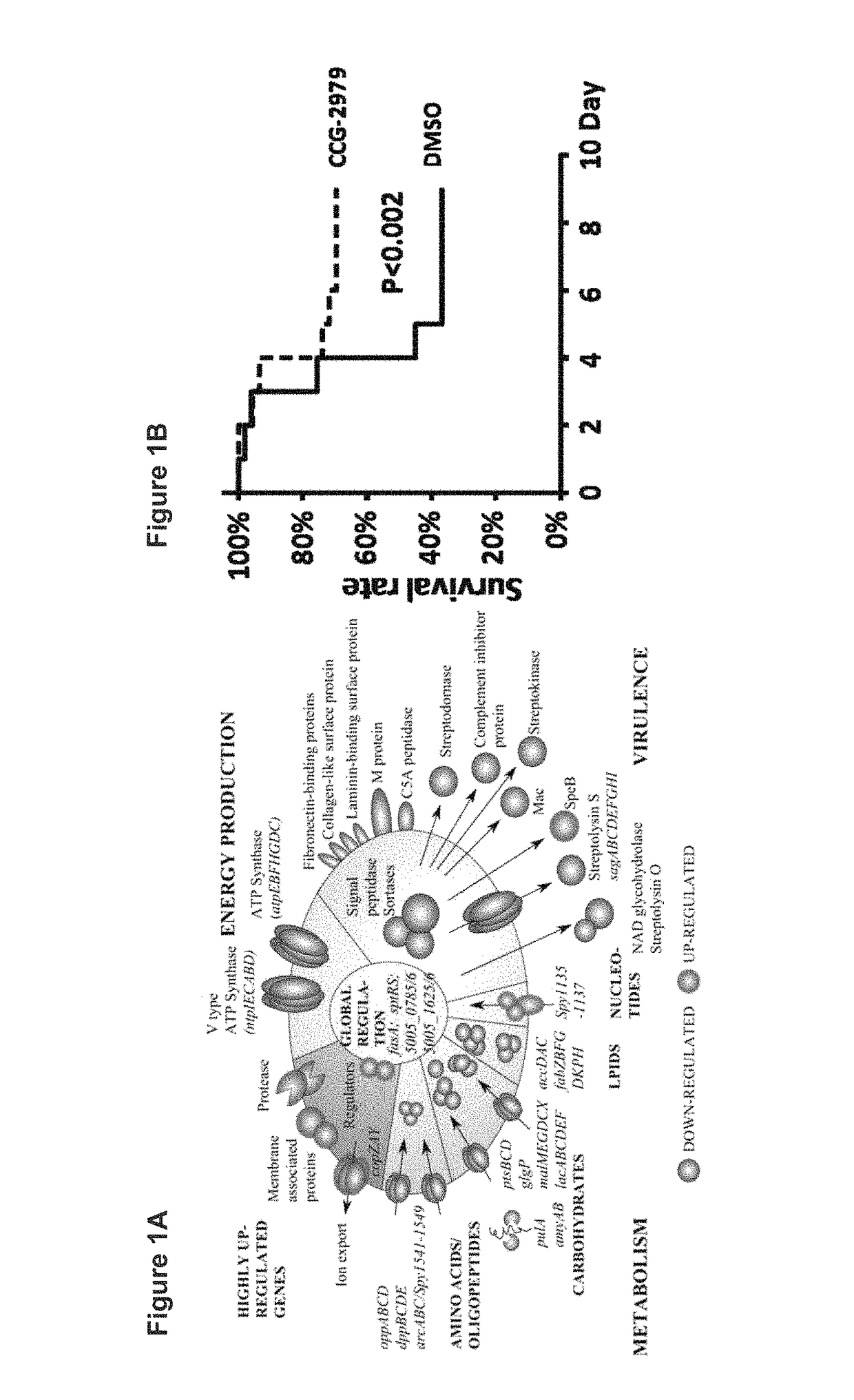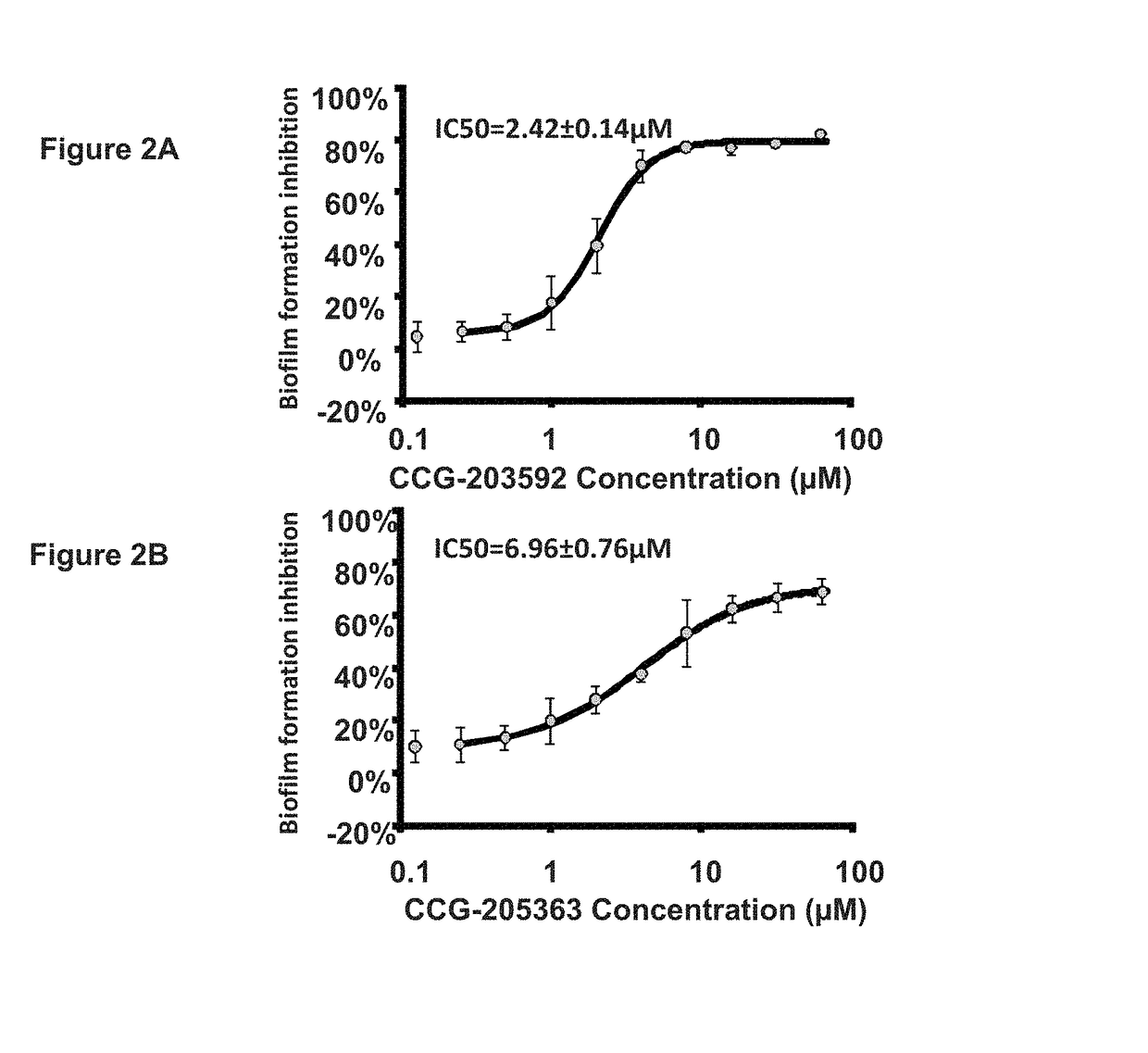Methods and compositions for treating bacterial infection
a technology of bacterial infection and composition, applied in the field of chemical compounds, can solve the problems of bacteria death or growth arrest, bacteria resistance becoming one of the leading public health threats, and biofilm formation on or within indwelling medical devices such as catheters, prosthetic joints, etc., and achieve the effect of reducing the efficacy of humans
- Summary
- Abstract
- Description
- Claims
- Application Information
AI Technical Summary
Benefits of technology
Problems solved by technology
Method used
Image
Examples
example 1
[0176]A chemical series of small molecular weight chemical compounds that are capable of inhibiting biofilm formation by S. aureus and S. epidermidis on different biomaterial surfaces were identified (Tables 1-4). These compounds are different from existing antibiotics or compounds under development by others in that they do not kill bacteria or inhibit bacterial growth but instead alter patterns of gene expression leading to reduced virulence.
[0177]Additional non-bactericidal anti-staphylococcus reagents for application to the surface of biomaterials used for making implantable medical devices, especially artificial heart valves, pacemakers, and catheters, to prevent or treat biofilm formation without resistance development are developed. These compounds can also be used to treat infections caused by S. aureus and / or S. epidermidis since they inhibit the gene expression of a number of important virulence factors.
[0178]An antivirulence approach was used to screen for small molecules...
example 2
Biofilm Inhibitors
[0190]The compounds described in Tables 1-4 find use in the inhibition of biofilm formation by a variety of organisms.
[0191]Table 1 shows inhibition of S. epidermis biofilm. Table 2 shows inhibition of S. aureus biofilm. Table 3 shows compounds with >20% inhibition of S. aureus biofilm at 100 or 50 μM. Table 4 shows compounds with >20% inhibition of S. epidermis biofilm at 100 or 50 μM.
[0192]
TABLE 1S. epidermis Biofilm inhibition5 μM10 μM50 μM100 μMvs. (−)vs. (−)vs. (−)vs. (−)Growth inhibitionCCG-No.ControlControlControlControl100 μM vs. (−) Control1024830.7861.2862030430.4021.1832030430.4370.8902030430.1690.451.032038040.0791.0342038040.8580.150.902038040.2521.0062040300.7391.1082040330.7561.0262053810.1110.8432053810.7560.5532053840.0581.0012053841.0950.200.922053840.2341.0142053900.0821.3502053900.9210.161.092053900.2951.0692053960.0370.1302054270.7660.9802054470.9360.181.042054470.2810.9352054470.4471.0062062270.9430.301.412062270.4981.4322062270.5991.314206239...
example 3
[0196]This example describes the synthesis of compounds of embodiments of the present disclosure. Synthesis of compounds with CCG designations 102483, 102485, 102491, 102493, 102495, 102620, 102622, 203037, 203039, 203041, 203043, and 203574 have been previously described in patent US20100331351; herein incorporated by reference in its entirety. The synthesis of compounds with CCG designations 203592, 203598, 203625, 203627, 203629, 203631, 203633, 203803, 203804, 204060, 205363, 205427, 205434, 205435, 205480, 206178, 206352, 206353, 206355, 206356, and 206358 are fully described and spectrally characterized by Yestrepsky et al. Bioorganic Medicinal Chemistry 2013, 21, 1887-1897; herein incorporated by reference in its entirety. The synthesis of the remaining compounds is described below.
Experimental and Spectroscopic Data of the Compounds
[0197]Chemistry. Chemical names follow CAS nomenclature. Starting materials were purchased from Fisher, Sigma-Aldrich Lancaster, Fluka or TCI-Ame...
PUM
| Property | Measurement | Unit |
|---|---|---|
| particle size | aaaaa | aaaaa |
| temperature | aaaaa | aaaaa |
| temperature | aaaaa | aaaaa |
Abstract
Description
Claims
Application Information
 Login to View More
Login to View More - R&D
- Intellectual Property
- Life Sciences
- Materials
- Tech Scout
- Unparalleled Data Quality
- Higher Quality Content
- 60% Fewer Hallucinations
Browse by: Latest US Patents, China's latest patents, Technical Efficacy Thesaurus, Application Domain, Technology Topic, Popular Technical Reports.
© 2025 PatSnap. All rights reserved.Legal|Privacy policy|Modern Slavery Act Transparency Statement|Sitemap|About US| Contact US: help@patsnap.com



